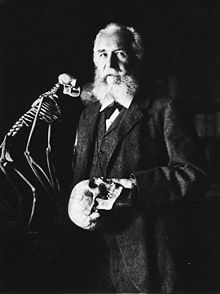Unless otherwise noted, the material on this page may be used under the terms of a
Creative Commons License.
| Biographies | ||
| Science | H |
| Science | ||
| Science | Timeline |
| Science Biographies Timeline Glossary References |
Biographies A-Z H References |

Haeckel, Ernst: (1834-1919) eminent German zoologist, naturalist, philosopher, physician, professor of comparative anatomy and artist who discovered, described and named thousands of new species, mapped a genealogical tree relating all life forms, and coined many terms in biology, including anthropogeny, ecology, phylum, phylogeny, and the kingdom Protista. His chief interests lay in evolution and life development processes in general, including development of nonrandom form.
Haeckel promoted and popularized Charles Darwin's work in Germany (Darwin's On the Origin of Species made a powerful impression on Haeckel when he read it in 1864,). His massive and ambitious Generelle Morphologie, published in 1866, presenting a revolutionary new synthesis of Darwin's ideas with the German tradition of Naturphilosophie going back to Goethe and with the progressive evolutionism of Lamarck in what he called Darwinismus. He used morphology to reconstruct the evolutionary history of life, in the absence of fossil evidence using embryology as evidence of ancestral relationships. He invented new terms, including ontogeny and phylogeny, to present his evolutionised recapitulation theory that "ontogeny recapitulated phylogeny". The two massive volumes sold poorly, and were heavy going: with his limited understanding of German, Darwin found them impossible to read. Haeckel's publisher turned down a proposal for a "strictly scholarly and objective" second edition.
Haeckel was an accomplished artist and illustrator, his published artwork of Haeckel includes over 100 detailed, multi-colour illustrations of animals and sea creatures (entitled Kunstformen der Natur, "Art Forms of Nature"). He was also one of the first to consider psychology as a branch of physiology. A flamboyant figure, he sometimes took great (and non-scientific) leaps from available evidence. For example, at the time that Darwin first published On the Origin of Species (1859), no remains of human ancestors had yet been found. Haeckel postulated that evidence of human evolution would be found in the Dutch East Indies (now Indonesia), and described these theoretical remains in great detail. He even named the as-of-yet unfound species, Pithecanthropus alalus. Eventually a young Dutchman named Eugene Dubois went to the East Indies and dug up the remains of Java Man, the first human ancestral remains ever found. These remains originally carried Haeckel's Pithecanthropus label, though they were later reclassified as Homo erectus (Wikipedia)
Hennig, Willi (1913 - 1976) German entomologist and taxonomist; founder of phylogenetic systematics (later known as cladistics). He specialised in the taxonomy of dipterans (flies and mosquitoes). In 1950, he proposed a method for determining phylogenetic trees by classifying organisms according to their shared derived morphological characters, which are called synapomorphies (Hennig 1966). He developed cladistics as a way to compensate for the very scrappy fossil record of insects when trying to construct the evolutionary history. In his 1950 opus Grundzüge einer Theorie der phylogenetischen Systematik ("Basic outline of a theory of phylogenetic systematics"), republished in English as Phylogenetic Systematics he proposed a rigorously logical protocol based on evolutionary branching or cladogenesis as a phylogenetic methodology. The term cladist, for an adherent of Hennig's school, was coined by Mayr in 1965; Hennig himself referring to his own approach as phylogenetic systematics. The term Phylogenetic Systematics is here used to refer to the classic form of cladistics proposed by Hennig, in opposition to rival and less succesful interpretations such as Pattern Cladism. During his life Hennig's methodology remained a minority approach to classification, but in the 1980s and 1990s his work resulted in a paradigm shift which replaced the then current Modern Synthesis' methodology of evolutionary systematics with the current phylogenetic approach. Phylogenetic systematics is now almost universal in paleontology and molecular phylogeny, but has much less influence in botany, due to the latter's heritage of Linnaean taxonomy. (MAK, Wikipedia). Link - pdf essay: Willi Hemiig and the Rise of Cladistics; The Willi Hennig Society
Hitchcock, Edward (1793 -1864) American geologist who surveyed much of New England; he also published papers on fossilized tracks in the Connecticut Valley, including Eubrontes and Otozoum, which he believed were made by gigantic prehistoric birds (they are now known to be dinosaur tracks, but cladistically speaking, birds are dinosaurs, so he was right after all MAK111205 (Wikipedia)
Holtz, Thomas R., Jr., : vertebrate palaeontologist and senior lecturer at the University of Maryland's Department of Geology, published extensively on the phylogeny, morphology, ecomorphology, and locomotion of terrestrial predators, especially theropod dinosaurs. (Wikipedia
Hutton, James: (1726-1797) Scottish farmer and geologist. In his travels around Britain, he made observations which suggested to him that the geologic processes that shaped the ancient Earth could be seen operating all the time, an idea which would later form the basis of Lyell's uniformitarianism. Hutton used his observations and hypothesis to argue that the Earth must be extremely old. (UCMP Understanding Evolution Glossary) Link: James Hutton
Hyatt, Alpheus: (1838–1902) American zoologist and palaeontologist. Studied under Louis Agassiz; along with Edward Drinker Cope was the most prominent American neo-Lamarckian. Advocated a theory of "racial senility" based on the analogy of ontogeny with phylogeny, which became the foundation of orthogenetic theories in the U.S.; his followers included C. Beecher at Yale. Founder and first editor of the American Naturalist; first president of Woods Hole laboratory. ( John Alroy - Lefalophodon, Wikipedia,)
new page MAK111204